#Bruce Surtees
Photo
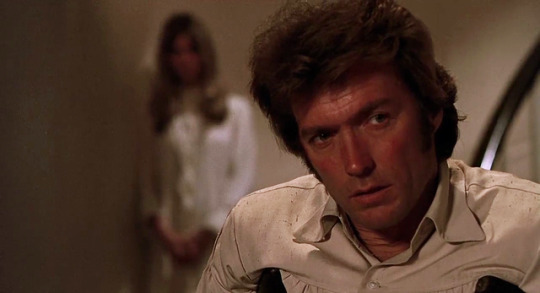




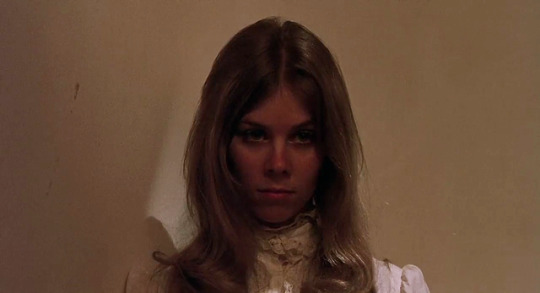



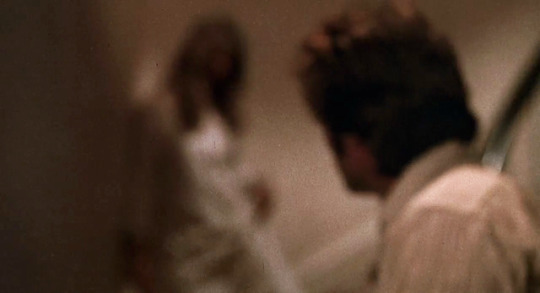
The Beguiled (Don Siegel, 1971).
#the beguiled (1971)#don siegel#jo ann harris#clint eastwood#bruce surtees#carl pingitore#ted haworth#the beguiled#el seductor#el seductor (1971)#sesión de madrugada#sesiondemadrugada#movie stills#movie frames#albert maltz#irene kamp#thomas cullinan#claude traverse
51 notes
·
View notes
Photo





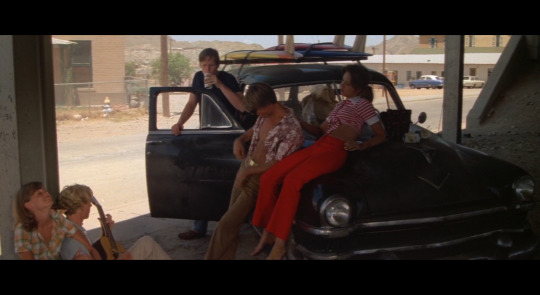


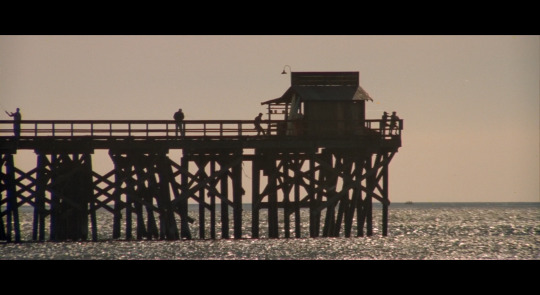

big wednesday (john milius, 1978)
21 notes
·
View notes
Photo
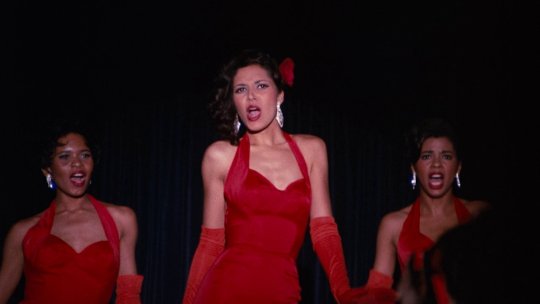
Sparkle (1976)
In 1959, three young women in Detroit’s Brewster-Douglass Housing Projects came together to form a musical trio. Sixteen-year-old Florence Ballard first convinced her best friend, Mary Wilson, fifteen, to join the group; Wilson then recruited Diana Ross, also fifteen, to join. On weekday evenings and weekends, the Primettes (the “sister group” to the Primes, later known as the Temptations) performed at local clubs and talent shows across Detroit, often covering hits from the Drifters and Ray Charles. The Primettes became a local sensation, winning a competition at the 1960 International Freedom Festival, and attracting the attention of Motown founder and executive Berry Gordy. Gordy signed the Primettes to a contract in early 1961, on stipulation they change their name. They became the Supremes.
One decade later in American cinema, the major Hollywood studios began experimenting with and quickly realized the box office appeal of blaxploitation. Blaxploitation is a type of exploitation film that features heavily – if not entirely – black casts and narratives, often aimed at an urban African-American audience. Generally, the subgenre concurrently provided a valuable avenue for black representation in Hollywood (on- and off-camera) and narratives concerning the community, all while upholding damaging white stereotypes about black people (i.e., violence, substance abuse, the hypersexualization of black women and highly polarized sexualization of black men with little in-between, etc.).
Released by Warner Bros., Sam O’Steen’s Sparkle, takes inspiration from the history of the original members of the Supremes. Sparkle arrived long after the breakup of the original Supremes (Ross departed in 1970; Ballard in 1967, but passed away two months before Sparkle’s release) and before the 1981 Broadway debut of Dreamgirls (which has a narrative with the same inspiration and story arc). Likewise, the film made its theatrical debut at a moment when blaxploitation was undoubtedly in decline. Repeated criticism from the National Association for the Advancement of Colored People (NAACP), the decision of some of the subgenre’s stars to pursue interests elsewhere, and impatience for blaxploitation’s typical low production values all contributed to that drop-off. Sparkle carries elements of blaxploitation (as do many films centered on African-American characters), but, despite its myriad of flaws, it represents a glimpse of the future of black American cinema.
It is 1958 in Harlem, New York City. The Williams sisters – youngest Sparkle (Cara; the obvious Diana Ross analogue), middle sister Delores (Dwan Smith), and eldest Sister (Lonette McKee; whose character starts out as the lead singer) – and friends Stix (Philip Michael Thomas) and Levi (Dorian Harewood) decide to take their church singing experience to form a musical quintet. The sisters’ mother, Effie (Mary Alice), works long hours as a maid, and has little time to tend to her children. Without much consideration other than requesting promises that the Williams daughters’ schoolwork remains their priority, she lends her blessing to their idea. Dubbing themselves the Hearts, a successful showing at a local talent competition has everyone imagining how they might have a future as professional musicians. Both young men drop out of the group – Levi so that he can take a job with a gangster named Satin (Tony King); Stix becomes the now-trio’s manager and co-composer. The trio, now known as Sister and the Sisters (I would have kept the original name), soon become the headline act at the sordid Shan-Doo Club. There, the malicious intentions of others and unfortunate incidents will challenge the fabric of the group and the bonds of sisterhood between Sparkle, Delores, and Sister.
At a brisk ninety-eight minutes, Sparkle wants to balance the narratives for Sparkle, Delores, and Sister as much as it can. But Joel Schumacher’s (1978’s The Wiz, 2004’s The Phantom of the Opera) screenplay and Howard Rosenman’s (1991’s Father of the Bride, 2017’s Call Me By Your Name) story serves no one particularly well. Given that the film is named after the youngest of the Williams sisters, it makes sense that Sparkle receives the most attention. However, the pedestrian dialogue – especially in the most heightened romantic and violent moments of the films – provides Irene Cara little to work with. And if the ostensible lead actress is ill-served by the screenplay, the situation is worse for everyone else. Sparkle’s storyline – despite a worthy message of how she cannot depend entirely on others to find happiness or success – lurches from one cliché to another, the typical rags-to-riches story executed more interestingly in scores of films that came before and after this.
The connections to Delores and Sister’s stories are likewise poorly handled and edited, with transitions too abrupt for any sort of reflection about the scene prior. We learn about Dolores’ interest in joining the civil rights movement, but this character detail has no depth despite its centrality to a crucial plot point. Sister’s eventual drug abuse and domestic (and potentially, sexual) abuse from her partner is entirely one-dimensional – as if lifted from a shabby blaxploitation film with even less regard for its characters. Her fate feels preordained from the moment we learn of her quandary. Sister’s part in Sparkle is sensationalistic, torturing her and her loving sisters almost for the sake of it.
I can understand how the extremely simplified dialogue in Sparkle might be realistic, but the screenplay is also devoid of geographic, historical, and racial vernacular that places the audience firmly in the film’s setting. Rarely did I ever feel that this was a film set in Harlem, let alone New York City in the late 1950s. New York City – and Harlem moreso than most neighborhoods – is itself a character in many films set in the Big Apple. Bruce Surtees’ (1971’s The Beguiled, 1984’s Beverly Hills Cop) anonymous cinematography also undermines this aspect of the film. The lack of variety beyond Surtees’ medium and medium-close shots renders Sparkle a tedious watch. The film never suggests the claustrophobia that many contemporary independent films rely on to suggest intimacy or entrapment. Nor does the camera pull back far enough to bask in the magnificence of New York City, any of the featured musical venues, or even the bodily movement in some of the sisters’ musical performances.
Surtees’ purported lack of experience in lighting for scenes featuring non-white people also results in all the musical performances – outside of the spotlight beaming towards any of the performers – being surrounded in pitch darkness. In terms of lighting, this is an exceptionally dark movie during those moments, as one can barely make out backgrounds or furniture or even some facial expressions and features because of the poor lighting. It is almost as if Surtees wanted to capture the impression that one experiences when coming into a dimly lit room after exiting a daytime exterior. One’s eyes have not adjusted to the darkness, so the interior seems darker than it is. The only problem is that Surtees never adjusts, and it is not clear what purpose this serves emotionally, narratively, or even atmospherically (because almost all other interior scenes in Sparkle are also underlit, just not as intensely as the musical scenes). Your experience in watching Sparkle may vary depending on the quality of the print you watch, largely due to the poor cinematography and lighting that makes certain formats and editions unwatchable. This write-up is based on the print made available for broadcast on Turner Classic Movies (TCM).
The composer for Sparkle, Curtis Mayfield, was an innovator in soul music and 1960s R&B. Mayfield, one of the original members of the Impressions (whose original lead singer was Jerry Butler; “For Your Precious Love”, “People Get Ready”), left the group in 1970 for a solo career. His filmography, though not lengthy, nevertheless included one of the most popular blaxploitation films of all in Super Fly (1972). Part of Mayfield’s reasoning for leaving the Impressions was to find the freedom to integrate his music with a social consciousness (as one can hear in the Impressions’ “People Get Ready” and the songs in Super Fly). But for a project like Sparkle, Mayfield would have to find a way to replicate the Motown sound, style, and lyrics of early ‘60s girl groups. He may not have been the ideal candidate for this mode of R&B and soul (and one can hear it in this film at times as a handful of the songs pass too long without a quotation of the chorus), but Mayfield produces an always-listenable score and set of songs for Sparkle.
youtube
The Hearts’ debut number, “Jump”, has minimal instrumentation: percussion and select stabs of brass. It is a basic start, acted wonderfully by the quintet by showcasing the initial awkwardness that only begins to truly groove about a minute in. The boys, Stix and Levi, are obviously vestigial to the performance because neither sings, both only half-clumsily (look at 1:23 in the provided video) adding to the choreography. It works in the narrative context of the film. Once the Hearts become Sister and the Sisters, then the performances garner more musical interest. “Hooked On Your Love”, the group’s debut performance at the Shan-Doo Club, might be the most Supremes-like song in the soundtrack. From the choreography that just evokes the grainy videos one might find on YouTube of early ‘60s girl groups, the era-appropriate vocal ornamentations, and the fact that all three actresses (especially) Cara are having a blast performing, “Hooked On Your Love” is just a knockout of period musical goodness. I just wish the camera drew back a little longer so we could see all three sisters for longer stretches of time (and again, pity about the lighting). Cross-cut with images of Sister’s relationship and personal troubles, “Giving Him Something He Can Feel” is a wonderful mid-film number, for the same reasons as “Hooked On Your Love” works musically. Here, however, there is more narrative and visual interest. Its placement and the editing here – see those wary glances from their mother towards the disreputable crowd during the performance – is the film’s Rubicon crossing.
With such a great slate of songs, what a shame it is that none of the film’s original performances are available in soundtrack form. Instead, Aretha Franklin is the sole performer on the soundtrack, as she covers all the songs. No disrespect to Aretha (in my book, at least in the top five of vocalists in any genre during the last century), but the original performers deserved more respect in a commercial release of the film’s soundtrack. As it is, the original in-film performances are easily searchable, so one can enjoy the movie and the soundtrack versions and appreciate the artistry of Aretha, as well as that of Irene Cara, Lonette McKee, and Dwan Smith.
A year after appearing in Aaron Loves Angela (1975), Irene Cara had now starred in two major studio production a year apart. Neither film was a box office success – Sparkle’s box office records remain unknown, so I am going off educated guesses from a variety of sources – but this was still a point of pride for Cara to achieve so much just as she turned seventeen years old. Her best-known accomplishments in acting and singing in Fame (1980) and her Academy Award win for the title song to Flashdance (1983) would not be far off. Lonette McKee, in her film debut, would carve out a stable career through the 1970s and ‘80s, with appearances in Francis Ford Coppola’s The Cotton Club (1984) and Walter Hill’s Brewster’s Millions (1985). Dwan Smith has largely faded from the public eye since Sparkle.
As one of the late Whitney Houston’s favorite films, Sparkle was remade in 2012 starring American Idol winner Jordin Sparks, Carmen Ejogo, and Tika Sumpter as the sisters and Houston as their imperious evangelical mother. 2012’s Sparkle was Houston’s final film, and has been almost universally compared unfavorably to the original. Sparkle has, over the years, become a cult favorite among African-American audiences. Curtis Mayfield’s songs and associated performances, alongside a sincere (if incomplete and poorly photographed) depiction of black life in New York City were more than enough to help the film achieve that status. My reservations aside, the original Sparkle deserves that chance for audience reevaluation.
My rating: 5/10
^ Based on my personal imdb rating. My interpretation of that ratings system can be found in the “Ratings system” page on my blog. Half-points are always rounded down.
For more of my reviews tagged “My Movie Odyssey”, check out the tag of the same name on my blog.
#Sparkle#Sam O'Steen#Irene Cara#Philip M. Thomas#Lonette McKee#Dwan Smith#Mary Alice#Dorian Harewood#Tony King#Joel Schumacher#Howard Rosenman#Bruce Surtees#Curtis Mayfield#WB100#TCM#My Movie Odyssey
2 notes
·
View notes
Text
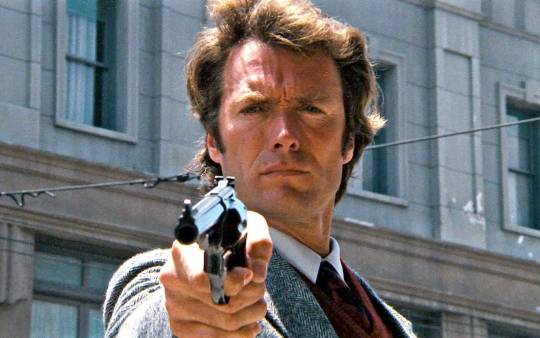
.
I know what you're thinking. "Did he fire six shots or only five?" Well to tell you the truth in all this excitement I kinda lost track myself. But being this is a .44 Magnum, the most powerful handgun in the world and would blow your head clean off, you've gotta ask yourself one question: "Do I feel lucky?"
Dirty Harry, Don Siegel (1971)
#Don Siegel#Harry Julian Fink#Rita M. Fink#Dean Riesner#Clint Eastwood#Harry Guardino#Reni Santoni#John Vernon#Andrew Robinson#John Larch#John Mitchum#Mae Mercer#Bruce Surtees#Lalo Schifrin#Carl Pingitore#1971
0 notes
Text


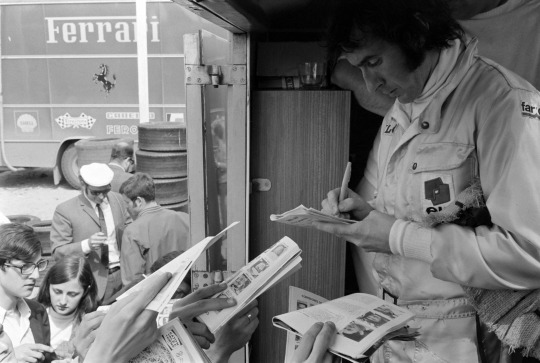



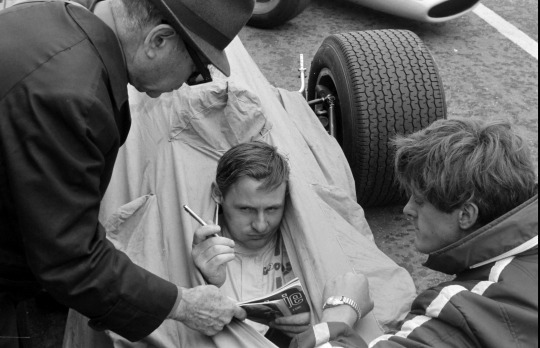


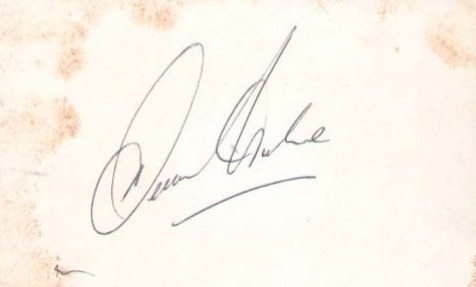


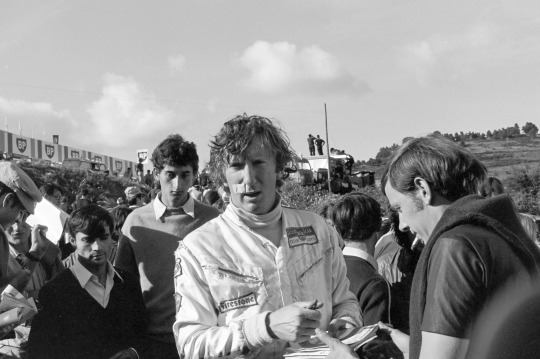


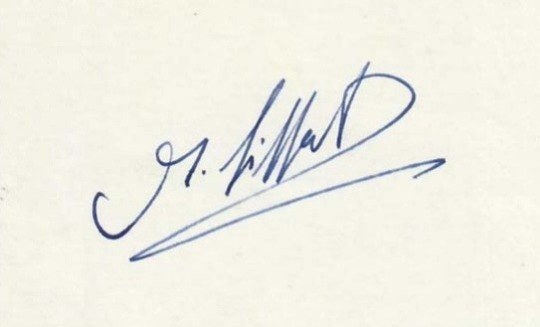


1960s F1 DRIVERS SIGNING AUTOGRAPHS + THEIR SIGNATURE
#i thought this would be cute </3#the signatures are from the iconic a-la-rascasse... we miss u laura !!!#ahh i gotta tag everyone right....#well starting from the top#john surtees#jackie stewart#jim clark#bruce mclaren#denny hulme#jack brabham#who is looking hella fine... damn girl....#jochen rindt#jo siffert#graham hill#classic f1#f1#formula 1#1960s
49 notes
·
View notes
Photo

Départ du Grand Prix d'Italie - Monza 1968 - 14 John Surtees (Honda), 2 Bruce McLaren (McLaren-Ford), 9 Chris Amon (Ferrari), 4 Jacky Ickx (Ferrari) 16 Graham Hill (Lotus-Ford). - source F1 Old and New.
#grand prix d'italie#monza#john surtees#bruce mclaren#chris amon#jacky ickx#graham hill#honda#mclaren-ford#ferrari#lotus-ford
48 notes
·
View notes
Text
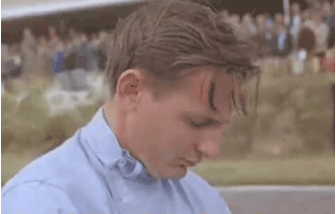



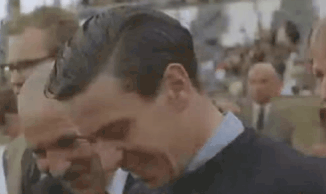


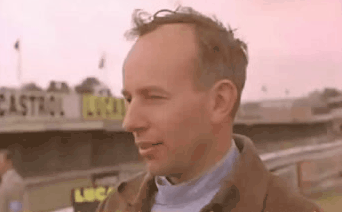


Some of the drivers prior the start of the British GP 🇬🇧, 1964.
#this was already in a low resolution and my phone lowered it even more ugh#happy to finally know where that clip of bruce is from!! <3#bruce mclaren#graham hill#jim clark#john surtees#jack brabham#classic f1#f1#formula 1#retro f1#f1 1960s#motorsport#60s
78 notes
·
View notes
Text
various formula one drivers assist in the maintenance of their vehicles


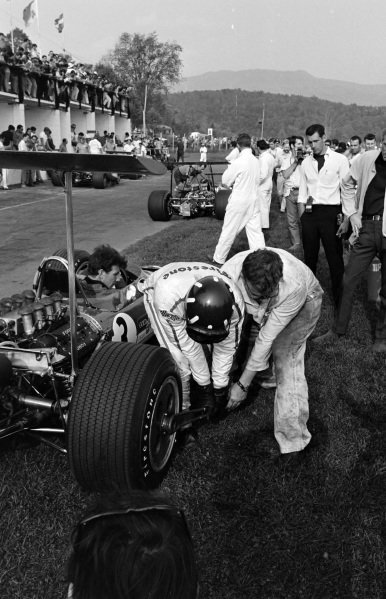
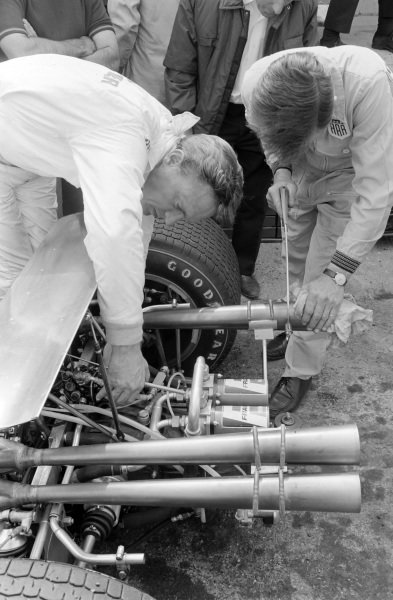
plus a bonus!

jim, will you always be shirtless?
#that would be impossible today :(#f1#classic f1#formula 1#retro f1#vintage f1#graham hill#john surtees#dan gurney#denny hulme#(and sitting on a tyre...laura get ready...)#bruce mclaren#this is late but happy birthday bruce!#aaaand#jim clark
21 notes
·
View notes
Text

Great driver from the past, in lineup Jim Clarck, Jhon Surtees, Bruce Mc Laren.
0 notes
Text

girls when he rounds the parabolica then to start his final lap in this race and you can bet your bottom dollar that no one is gonna be sat down at all as they make their way around 3.6 more miles let's look at the list ascari phil hill surtees scarfiotti regazzoni scheckter berger schumacher barrichello alonso ferrari drivers that have won here at monza and this man charles leclerc is about to add his name to that list and that means something bottas has been given the power he's been given the tools to chase after charles leclerc but he is a bit too far back leclerc who won in spa of course last week and might join this list bruce mclaren nigel mansell damon hill mika hakkinen and lewis hamilton drivers in the world championship who've won their first two grand prix back to back have a listen to that they rise through the ascari chicane ascari the legend that of course won here for ferrari and they rise to charles leclerc he can see the celebrations starting he's got one more corner the famous parabolica to go mercedes threw everything at him today charles leclerc has coped brilliantly he won in spa he wins in monza charles leclerc is the winner of the 2019 italian grand prix how about that
286 notes
·
View notes
Text
1966 St. Jovite (Mont Trembant)
The 1st ever Can-Am Race.
Front row, from pole. John Surtees 🇬🇧 (Lola T70 with Bruce and Chris Amon 🇳🇿 alongside)
Surtees would win, with Bruce very close behind.

6 notes
·
View notes
Photo

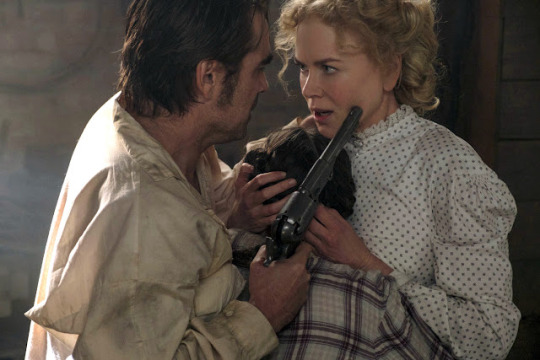
Geraldine Page and Clint Eastwood in The Beguiled (1971)
Colin Farrell and Nicole Kidman in The Beguiled (2017)
The Beguiled (Don Siegel, 1971)
Cast: Clint Eastwood, Geraldine Page, Elizabeth Hartman, Jo Ann Harris, Darlene Carr, Mae Mercer, Pamelyn Ferdin, Melody Thomas Scott, Peggy Drier, Patricia Mattick. Screenplay: Albert Maltz, Irene Kamp, based on a novel by Thomas Cullinan. Cinematography: Bruce Surtees. Production design: Ted Haworth. Film editing: Carl Pingitore. Music: Lalo Schifrin.
The Beguiled (Sofia Coppola, 2017)
Cast: Colin Farrell, Nicole Kidman, Kirsten Dunst, Elle Fanning, Oona Lawrence. Angourie Rice, Addison Riecke, Emma Howard. Screenplay: Sofia Coppola, based on a novel by Thomas Cullinan and a screenplay by Albert Maltz and Irene Kamp. Cinematography: Philippe Le Sourd. Production design: Anne Ross. Film editing: Sarah Flack. Music: Phoenix
Why some movies get remade and others don't is one of the abiding mysteries of the business. There doesn't seem to be a very clear reason why Don Siegel's 1971 The Beguiled should be a movie that Sofia Coppola would choose to remake 46 years later other than that it's a pretty good premise: a wounded Yankee soldier is taken in by a Southern girls' school who hide him from the Confederates until events turn them against him. The premise does have a slightly pornographic quality to it, but that's unlikely to have motivated the remake. Whatever the reason, we now have two pretty good versions of the story, the first starring an actor who became known for a taciturn masculinity, the second with a softer, more feminine (not to say feminist, because who knows what that means in any given context) approach. In fact, the two films are almost complementary, notable as much for what the remake leaves out as for the way in which Coppola changes the tone of the first version. Siegel's film is rougher and more action-filled, and it treats the sexual tension of the material in a more heated manner -- not to say overheated, which the 1971 version veers toward in its suggestions that Martha, the girls' school headmistress, not only committed incest with her brother but also had a lesbian relationship with (or at least attraction toward) the head teacher, Edwina. Times have changed, and Coppola steers clear of both, probably because they add nothing to the main story and same-sex attraction doesn't have the the power to shock in 2017 that it did in 1971. Coppola also eliminates a major character from Siegel's version, the slave Hallie (Mae Mercer), who serves as a kind of interlocutor with Clint Eastwood's McBurney, the two commenting on their different forms of captivity. Although the major characters retain the same general outlines, Coppola's Martha and Edwina, Nicole Kidman and Kirsten Dunst, are less eccentric performers than Siegel's Geraldine Page and Elizabeth Hartman. I think this works to Coppola's benefit, making the women's turn against McBurney more startling, even a little tragic, than in Siegel's film. In Siegel's version, the girl (Jo Ann Harris) who lures McBurney, called Carol in his film, is more vulgarly hot to trot than Coppola's Alicia, played with more subtlety by Elle Fanning. As for the two versions of McBurney, Coppola gives hers more of a backstory: an Irish immigrant lured into the Union Army by the promise of ready cash when he agrees to serve as a substitute for a Yankee reluctant to fight. Colin Farrell is also a more versatile actor than Eastwood, whose tough guy persona makes it hard for us to credit his acquiescence. The scene in which McBurney eats the poisoned mushrooms comes off better in Coppola's version because Farrell lets us see the poison taking its effect, whereas Siegel decides not to show the effect on Eastwood's McBurney. Yet somehow, I prefer the Siegel film, perhaps because there's an inherent cheesiness to the story's melodrama that Siegel embraces but Coppola strives to downplay.
12 notes
·
View notes
Text
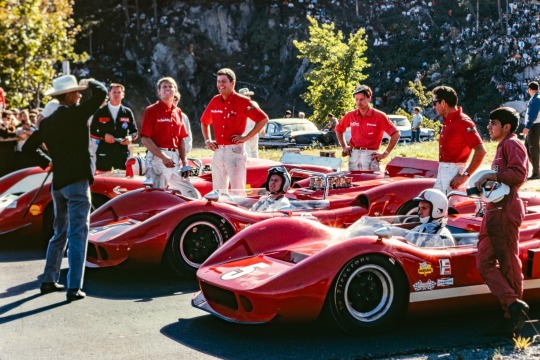
St. Jovite (Mont-Trembant) 1966. The first ever Can-Am race. Front row, from pole. John Surtees Lola T70, with Bruce and Chris Amon alongside. Surtees would win, with Bruce very close behind. This is a Robert (Bob) Gebert photo, courtesy of Glen Gebert.
1 note
·
View note
Note
In your about post, you mention your fav classic drivers, plus saying 'many, many more!'
I'm really interested in who the others are :D
hey! i was hopped up on painkillers while making that so i’m afraid ‘many, many more’ is quite an exaggeration. but i’ve gotten a little list below of the favourites i never got to mention above off the top of my head!
1950’s — alberto ascari, juan manuel fangio, stirling moss
1960’s — bruce mclaren, dan gurney, graham & phil hill, jacky ickx, jackie stewart, john surtees
1970’s — james hunt, niki lauda, jody scheckter, ronnie peterson, gilles villeneuve
1980’s — elio de angelis
1990’s — mika hakkinen, michael schumacher
might edit it later should i think of more names. thanks for the ask!
3 notes
·
View notes
Text
Films I’ve Loved This Year
I have already written reviews on some of them (not seen in this post), that you can already read here. So make sure to also do that.
I’m completely laid out in bed extremely sick, I thought between the delusional fevers, bomb exploding headaches, and literally feeling like I’m dying, I’d share the other films I’ve absolutely enjoyed watching this year.
I started up a separate account via Instagram to just post film, but having multiples is beginning to be too much, so from now on any other film content aside from the blog here will be on @ starrymayx.
So to start off the list here we go…
These 90s “Noir” films started my whole new movie Escapades, and I’m so glad they did -
Bad Influence, Guilty As Sin, Pacific Heights, Whispers in The Dark, Dream Lover, Untamed Heart, White Palace

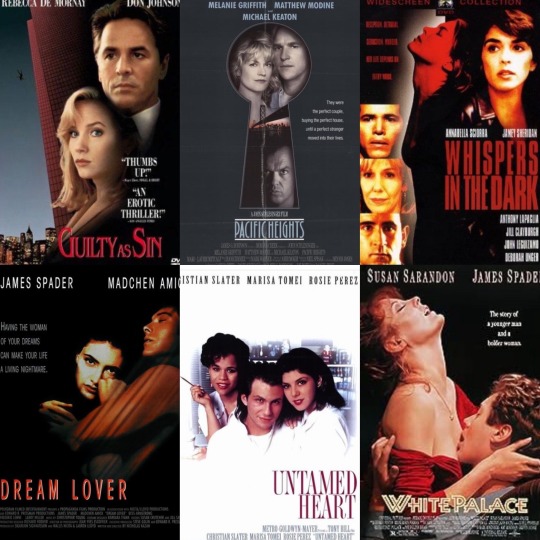
Here are the others…
Thrashin - 1986

Starring: Josh Brolin, Pamela Gidley
Brooke McCarter (RIP homie), Sherilyn Fenn, Robert Rusler, & Josh Richman
Anthony Kiedis + RHCP
Tony Hawk, Kevin Staab, Mike McGill, Jimmy Star
What I liked: There was so much awesomeness in this film and a feel good story of triumph. Basically it’s about two skateboarding gangs, having beef, mix in lots of skating, graffiti, punk rock aesthetics, and a love story, and you have yourself a pretty badass film. Plus they overcome their rivalry in the LA Massacre challenge, and there’s even several rat tails. 🤣 Definitely worth a watch!
I really wish I could skateboard. I would have been so rad. To all my skater friends and Bo’s over the years, mad respect. 🤘🏻
The House on Sorority Row - 1983
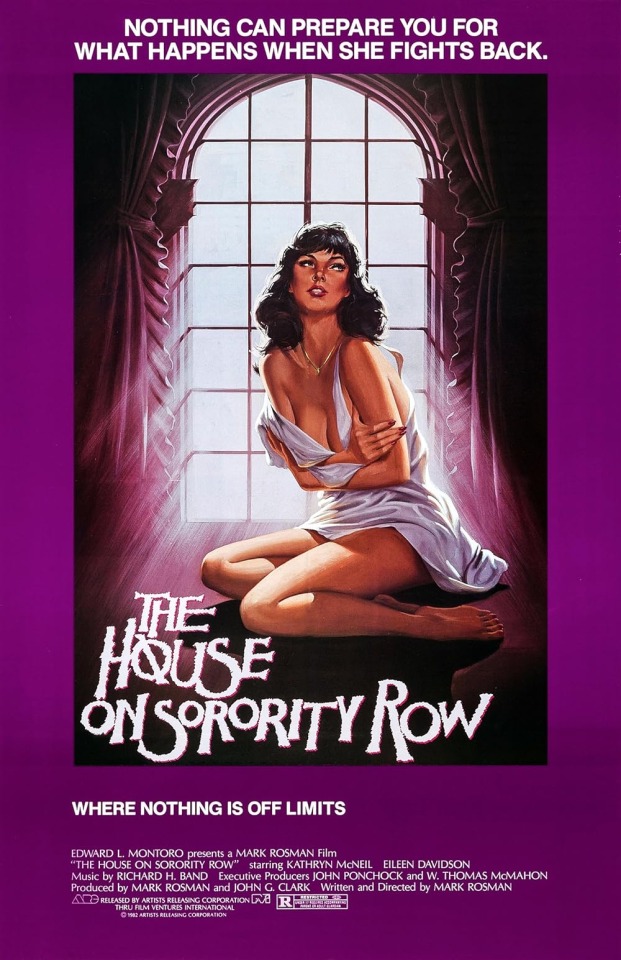
Director: Mark Rosman
I swear Scream Queens was influenced by this film.
I really liked it. Loved the lighting, still had a seventies type feel, storyline was really good. Definitely a film to check out if you like really good horror, without all the super special effects.
*For any strobe light sensitive people* like myself out there, there is a scene where it’s wild,
Pump Up The Volume ✊🏻 1990
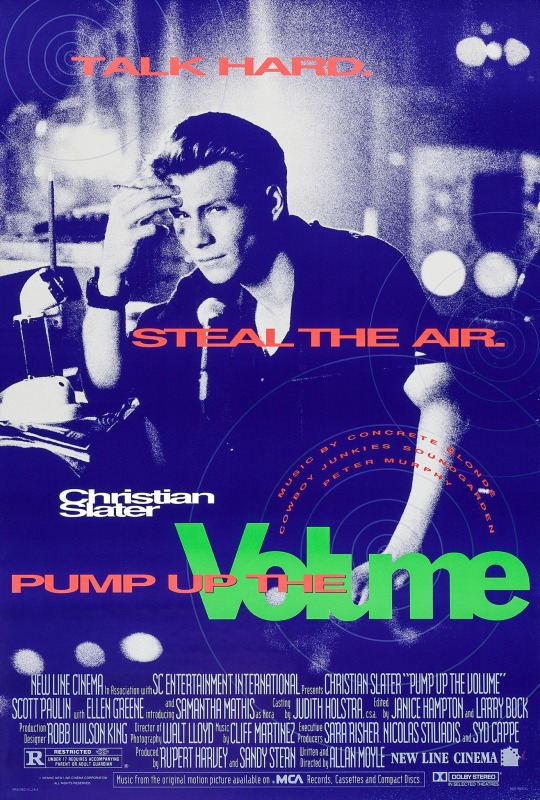
Director Allan Moyle
This movie is 🔥 Definitely a pioneer for all things talk radio but from a non-narrative perspective. Films like this and indie radio programs paved the way for our now podcasts. I loved the way it was written, the development of the characters personal selves, and breaking the rules.
I love me some Christian Slater 💓
The soundtrack is also amazing!
From Richard Hell, Leonard Cohen, Beastie Boys, Ice T, & more! I’ll link the soundtrack in my stories.
*trigger warning: there is a scene that deals with suicide and those scenes always get me. So I wanted to mention that.
Out of Bounds - 1986

Director- Richard Tuggle
Cinematography - Bruce Surtees
Starring: Anthony Michael Hall
Siouxsie and the Banshees 🤘🏻💓
& Meatloaf (in like 3 scenes)
What I liked: The cinematography of downtown LA & Venice Beach California, (actually the whole film is beautifully done). The 80’s colors, Dizz’s home, her style. The fact that Anthony Michael Hall was a badass hero, taking down a heroin drug man with his knife throwing skills. Really good film.
2 Days in The Valley - 1996
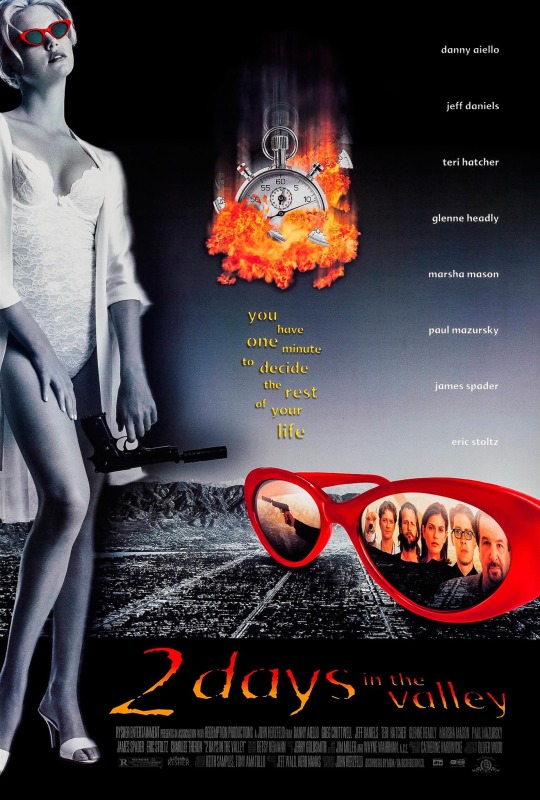
Written and Directed by: John Herzfeld.
Starring: James Spader, Eric Stolz & Charlize Theron
Synopsis: 48 hours of intersecting lives and crimes in The Valley of Los Angeles.
Why I liked it: Artsy Cinematography, James Spader obviously, and the correlation of numerous parties all being connected, going through individual stuff but being thrown into the mix of chaos. Plus sunglasses just seem to add viable cred to it. Why are sunglasses so cool yet mysterious?
Shampoo - 1975
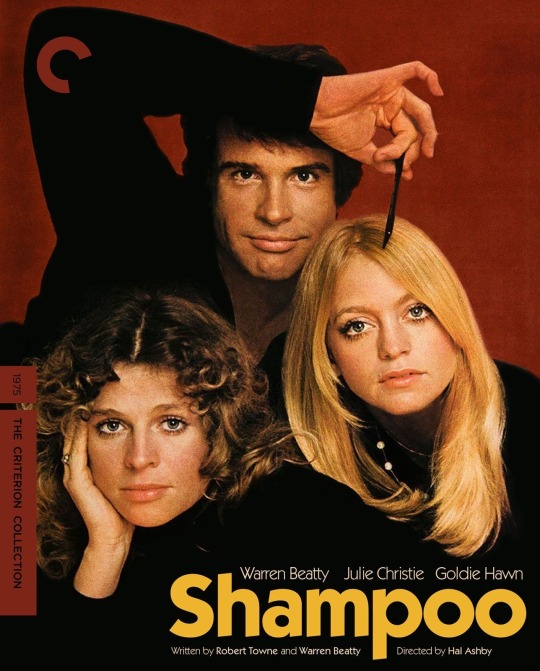
Director: Hal Ashby
Starting Julie Christie, Goldie Hawn, & Warren Beatty
I throughly enjoyed this film mainly due to the Jim Morrison/Sharon Tate style vibes it gave off throughout, and all the stylish decor/fashion. The Morrison looking guy played by (Warren Beatty) is basically a lover to many of his women hair clients (he does hair).
I really appreciate the 70’s swank and aesthetic appeal in this film. I’m also obsessed with Julie Christie’s glam Tate starlet look and I wish I could pull off bangs! Goldie Hawn is also in here and a younger Carrie Fisher.
From the 70s eye shadow, purple outfit I want, the main girls style, glamorous hair, river grotto, la house party with body paint and strobe lights (which that part I had to turn away - sensitive), it still rocked.

Based in the LA canyon/hills it’s definitely worth a watch to see the web of desire and aesthetic unfold. Keep your eye out for the creepy art in one of the scenes that just didn’t quite belong. 😳
Additionally there was some dialogue between two parties in the kitchen about questioning the lead male’s (hairstylist) orientation, and the f word was used a couple times. Didn’t like that part.
Really glad we’ve evolved on how we should identify people and what’s right to say and not to. A person can be gay or even not, but using derogatory terminology to hurt them is very low par. If you still do that. Stop.
Chopping Mall - 1986
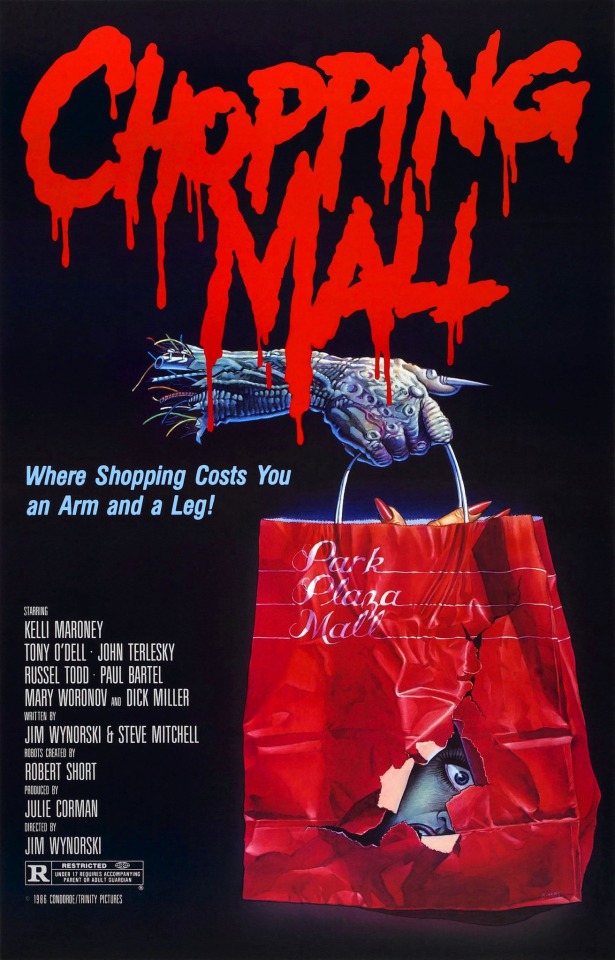
Director: Jim Wynorski
Mall Location: Sherman Oaks Galleria
I loved this film. For reals.
Nothing better than a mall unleashing new technology security robots, only to go horribly wrong. Which I already knew where it was going as soon as it started 😂
Anyways a group of mall employee friends and two others throw a party in a bedding home store and get freaky - typical 80s horror, which I love. Then basically the robots go crazy and savage, hunting down all of them in a terminator/stranger things vibe kind of way. The aesthetic, 80s style, and scenery are very appealing, all the way down to even the playboy underwear from Miss Virgina Slims herself. Camel ciggs just won’t cut it. 😂
Lots of greats here, and I hope you check them out if you haven’t seen them.
Happy Filming 😘
0 notes
Text


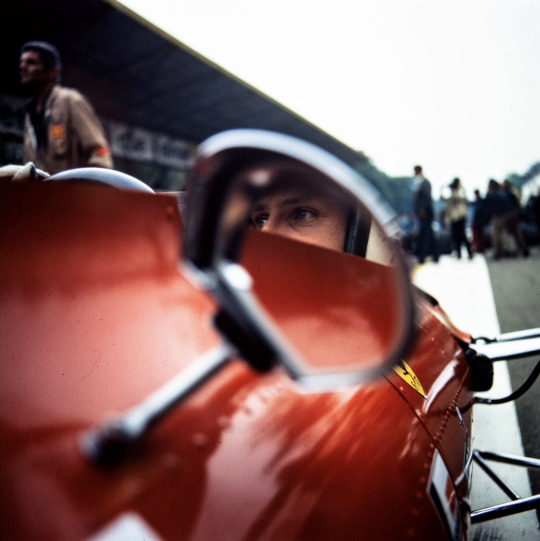

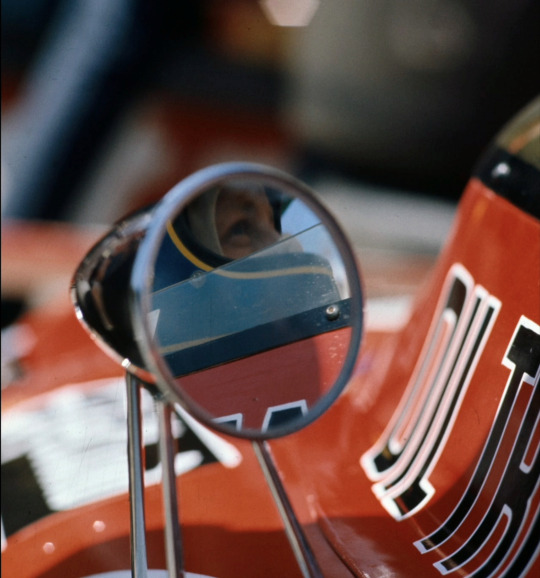

magic mirror on the car, who is the prettiest by far?
jack brabham // jacky ickx // chris amon // john surtees // ronnie peterson // bruce mclaren
#me: alright perfect i have all of my pictures#me: sees one with chris amon#me: lmao bye [redacted]#and i say i don't have my favourites!!#jack brabham#jacky ickx#chris amon#john surtees#ronnie peterson#bruce mclaren#classic f1#f1
11 notes
·
View notes